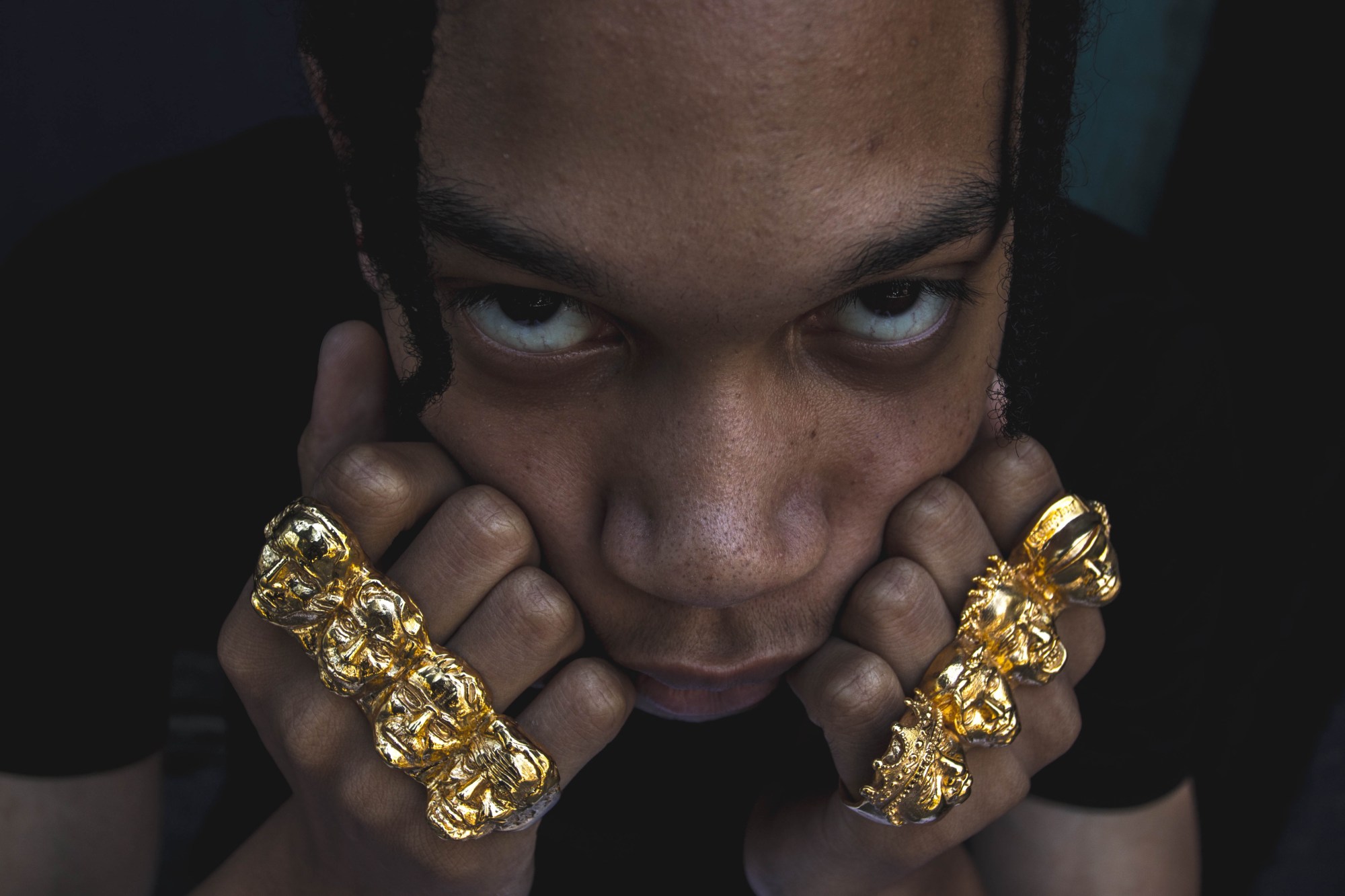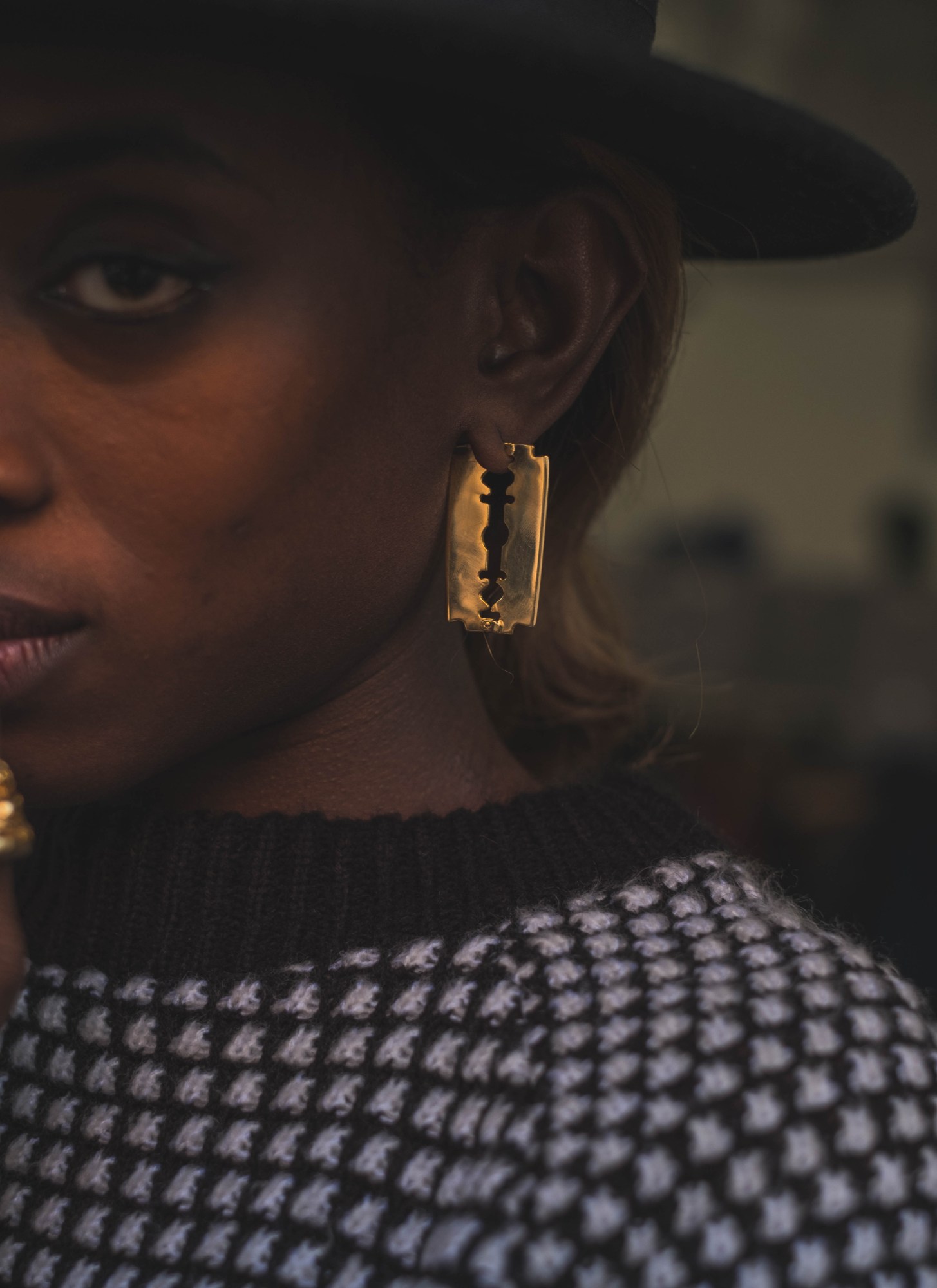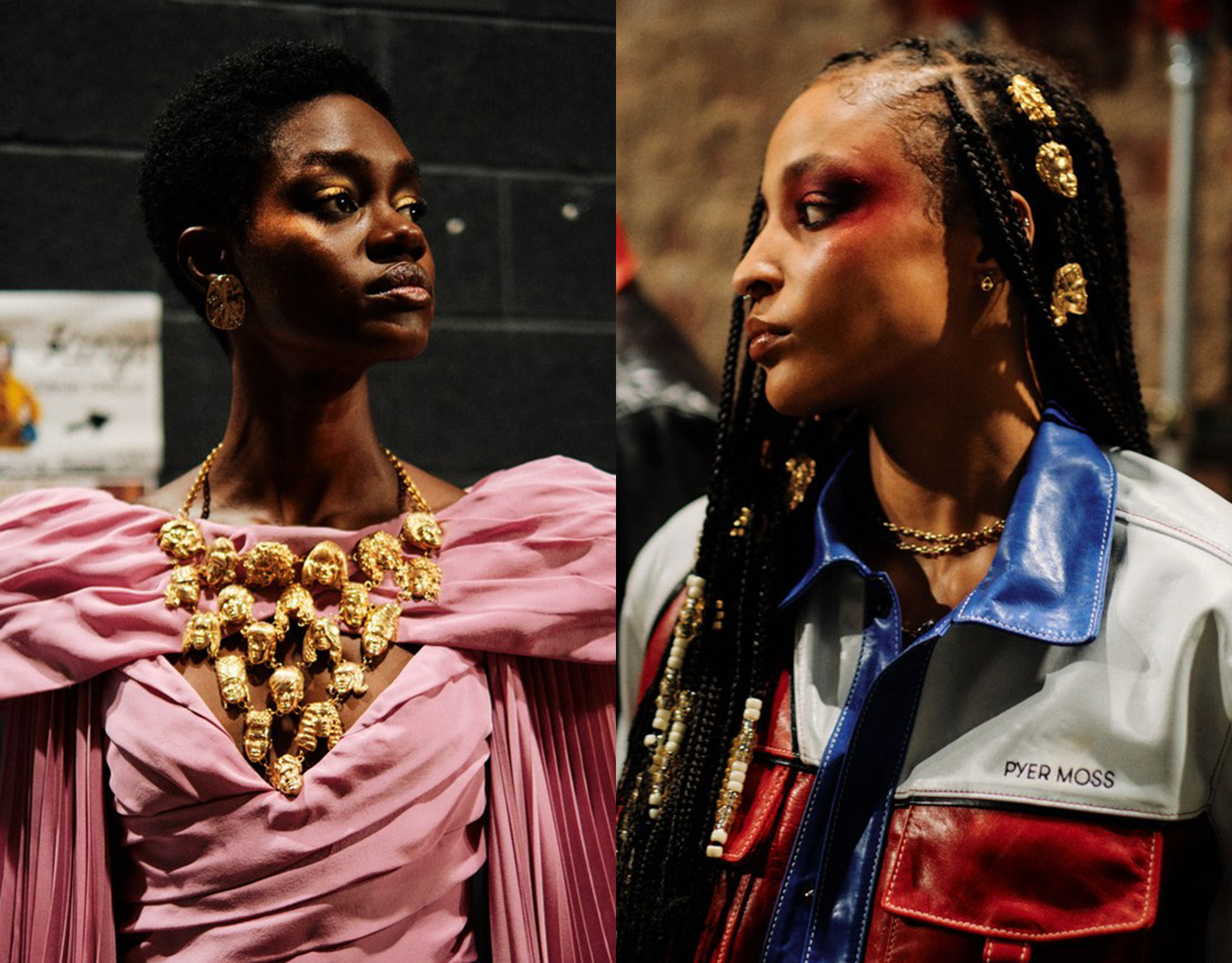As I sat with with Crown Heights-bred artist and entrepreneur Johnel Jamison on the top floor of the posh Dumbo House, sunlight from one of the most enviable views in Brooklyn glittered on the jewelry of his own design. Among the ornate necklaces, rings, and bracelets he was wearing that fall day, it was the gilded razor blade dangling from his ear and the golden, oversized Wu-Tang Clan symbol swallowing up his hand that seemed to shine the brightest.
“My pieces are more than just a shiny objects,” he said to me as he looked down at his hands adorned with his own art, “They actually make a statement and the connection is deep.”
The 31-year-old creates socially-conscious accessories under the moniker Johnny Nelson, which is a reverse portmanteau of his first name. The brand has received a great deal of praise this year, especially for its Pyer Moss collaborations.

For the Met Gala in May, Jamison outfitted Pyer Moss’s designer Kerby Jean-Raymond and Hollywood multi-hyphenate Lena Waith with custom sculpture portrait buttons featuring the faces of hip-hop legends (Jay-Z, Nipsey Hussle, J. Cole…) and LGBTQ icons (RuPaul, Dorian Corey, Freddie Pendavis…). They wore the buttons on streamlined zoot suits with exaggerated shoulders that were inspired by the film Malcolm X and perfectly fit the evening’s “camp” theme.
“People saw the buttons at the Met and now they want the lapel pins or cuff links,” he said, “I’ve gotten a lot more orders—custom orders, because it really opened up the creativity of the consumer. Now they are the designer.”
And in September for Pyer Moss’s 2020 “Sister” show for New York Fashion Week, Jamison helped Jean-Raymond achieve his goal of reclaiming rock n’ roll. Jamison did it by enshrining the faces of 20 iconic black women performing artists (Nina Simone, Diana Ross, Missy Elliot…) into golden hair beads, earrings, and sweeping necklaces that accessorized the vibrant, glamorous looks streaming down the runway.
“It’s so lit for my first runway show to be with Pyer Moss. That was such an epic moment,” he said of the show, which was hosted in his native Brooklyn at the Kings Theatre in Flatbush. “It was so packed out there, it was like going to Empire Skating rink on a Friday night back in the day.”
His work with Pyer Moss has certainly increased his profile as a jewelry designer. But even more importantly than the business side of things, the show in September was a sign to himself and his loved ones of how far he’s come in his life and proof that the work he’s done to heal from past tribulations is paying off.

Jamison was born in London and raised in Brooklyn. His childhood was typified by a tremendous amount of love at home provided by two artistic parents. His mom Glenice, who hails from the UK and knows how to dress like a diva on a budget, fostered his love of aesthetics and design and taught him how to make his own jewelry. While his dad Matthew, a native New Yorker who plays the church organ and makes hip-hop beats, gave him a passion for music that is still reflected in the jewelry he makes today.
But outside the home, he had to contend with a number of traumatic experiences that nearly squelched his creative potential.
One of the most wretched instances happened in 2004. Jamison and his friends were standing on the subway platform after catching a showing of Jay Z’s Fade to Black documentary, when they were approached by an NYPD officer who demanded that they leave. When they refused, the cop pepper sprayed the boys. After Jamison’s friend Mitchi Cunningham demanded the officer’s badge number, the cop struck the child.
“The officer took out his baton, and he cracked my friend in the head,” said Jamison. “Slow blood started pouring out. I have never seen anything like that in my life.” When Jamison tried to get help from another police officer, he was arrested and taken to jail. Cunningham had to receive neurosurgery as a result. While the boys eventually received a financial settlement from the city, the impact of that moment stayed with Jamison forever.
Four years later, when Jamison was 20 and starting to make a name for himself as a rapper, he was again attacked by the NYPD officers who caught him urinating in public. He told me they pummeled him senselessly.
“My tooth went through my lip. But they just kept going.” he said to me. “That was the most helpless I ever felt. They are supposed to be the people you call when you need help. But what do you do when they are the people hurting you?”
After being charged for assault, Jamison considered suing the NYPD again. But he decided against it because he believed his rap career would take off.

He was right. His street single “Put Em in a Body Bag,” which he recorded under the name Johnny Nelson, became a viral hit in the early 2010s, enabling him to tour alongside notable acts of the era like Ninjasonik. However, the trauma from those two events with the NYPD still weighed heavy on his psyche.
“I realize now that I probably have PTSD,” he said to me almost with disbelief.
To cope with his demons, Johnny turned to alcohol, which he indulged in more as his profile grew as an MC. “With partying, it’s so easy to get lost and forget what your path is,” he said.
But then, in short succession, he was hit with two wake-up calls. The first was the death of his close friend Ditto Castillo, who went by the name Ease Daman. Castillo was a fellow artist, who made rap music and worked for streetwear brands like Mishka. He died in 2013 due to complications with drugs. For Jamison, Castillo’s passing helped put the consequences of substance abuse into perspective.
The second was a brain hemorrhage Jamison suffered in 2015 caused most likely by a fight, but he doesn’t remember with whom or how it started because he was wasted at the time. “I was unconscious for days,” he said, “That messed me up. ”
But things began to turn around for Jamison in 2016, when he quit alcohol cold turkey after a marathon recording session with Melo X. As positive things started to happen, it reaffirmed the notion that being sober was the lifestyle for him.
“If you always had potential and you have people who look up to you,” he said, “Then no matter how far you fall, you have to get back up.”
Looking for a new way to express himself and make a living, Jamison turned to jewelry because people always loved the way he accessorized when he was rapping on stage.
“I used to throw parties with Ojay Morgan of the Zebra Katz and I would always wear these matches in my ear to those events. People would really look for that and tell me how fire it was,” he said with a laugh as he described the genesis of his Forever Lit earring, which features a metallic red enamel tip. “I had so much faith in this from the beginning because I already knew how successful it would be.”

As Jamison dove deeper into jewelry design, he relied on personal connections and mentors to help him realize his vision. “I basically went out to the diamond district and started asking around,” he said. “It’s about building relationships. I’ve become real close to people throughout the industry.”
This is especially true of other black designers in jewelry, since there are so few. “We all share what we know because it’s so hard to get stuff out here,” he said. “When I meet a black jeweler, I’ll ask homegirl, ‘Where do you go to get your plating done?” And she might ask me where I get something else popping. We’re not afraid to share with each other.”
In terms of design, Jamison feels his biggest breakthrough was his four-finger rings that feature iconic faces. To make them, Jamison starts with Adobe Illustrator. “I take pictures of their faces and put them together to see how they would line up on a hand,” he said. After that, it’s time to work by hand, carving the faces out of wax, which is used to make prototypes. This part of the process can take weeks.
“You have to have a lot of faith to prototype jewelry,” said Jamison. “There’s a lot of trial and error and it’s expensive because you’re working with metals.” When the prototype is finished, he’s able to make a silicone mold, which can be used to reproduce the ring in greater numbers with relative ease.
The first four-finger ring he started out with was Gold Rush, a piece that shrunk the presidential monument of Mount Rushmore down to the scale of the hand. “I made that just to grab attention and have people connect with something that they’ve never seen,” he said.
Towards the end of 2016, he started working on a hip-hop Mount Rushmore, focusing on rappers who touched him and also brought unique elements to the overall culture. Because the ring was a collection of faces, he was particularly focused on highlighting the artists’ “crown chakras.” “That’s where information and creativity comes from,” said the designer, before describing the unique crown of each icon on the ring. “Biggie is wearing a literal crown. Tupac has a bandanna. ODB has his wild crazy hair, and wild style in general. And Eazy-Z has his baseball cap, which kind of represents that he is like a man of many hats. He wasn’t just a rapper, he was NWA’s businessman.”
But the conjoined piece that speaks to him and his experiences most explicitly is his Let Freedom Ring, which features the faces of Martin Luther King, Malcolm X, Marcus Garvey, and Frederick Douglas. “This is my space to actually speak,” he said to me of the ring, “about the injustices I have been through firsthand with racism and police brutality. This ring starts that conversation.”

He also hopes these sorts of pieces give people who are facing the same obstacles that he faced strength to persevere. “People are powered by this jewelry,” he said. “They might cop a Marcus Garvey piece, and then want to open up their own business.”
He believes the power comes from the iconic figures he’s honoring. “Death doesn’t stop their energy,” he said. “But even though they didn’t finish what they came to do, their legacy lives on through us.”
But as important as the political element of his work is to him, his newfound platform has also allowed him to show love to those who stood beside him during his heralding journey to this point in his life.
At the Pyer Moss show in September, instead of bringing a romantic partner or a friend, the designer brought his mom Glenice as his date. For the special day, the stylish mom matched her vintage Gucci belt and kimono with earrings and a necklace designed by her son.
“Back in the day, she had to pick me up from jail,” he said with a dark laugh. “Going from that to being able to take her to a runway show that I was actually a part of—and her being the one who taught me everything I know about style—it was just a huge moment.”
But as successful as the designer is today, he’s still committed to working through his trauma so that he can continue to manifest more of his success. Now that he’s done with alcohol (he ordered a seltzer water from the bar at the Dumbo House), he’s studying organic healing techniques, practicing meditation, and considering more traditional forms of counseling. All of this work is, in his words, to go back into his past and face the root of his pain.
“All of these blessings have been happening because I have gotten past a lot of the bad stuff in life,” he said with a sigh of relief, “I’m doing the work that I need to do on myself, which is why the jewelry I make is always purposeful.”

